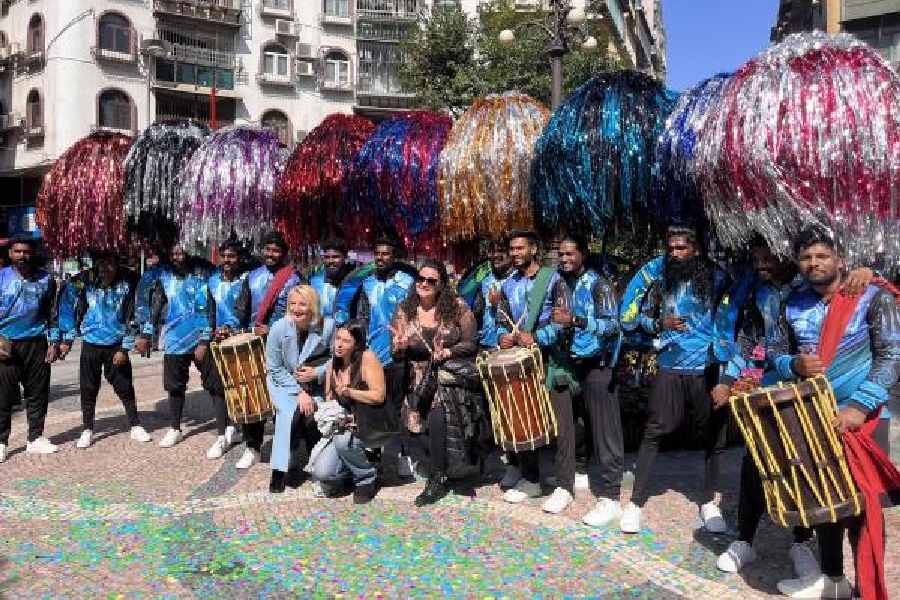 |
| A spread of luchi, vegetables and sweets at Sambhunath Ghosh’s Lakshmi puja. Pictures by Anup Bhattacharya |
She is worshipped as Kalabou, as Nabapatrika or as the consort of Narayan, in pictures on earthen plates or as idols, with grandeur or in simple ceremonies. But worshipped she is, on Kojagori Purnima, for Lakshmi, the goddess of wealth, is the harbinger of all good things.
At Sambhunath Ghosh’s house near Batore More, Lakshmi-Narayan were family deities till 1970. The family, originally from north Calcutta, shifted to Howrah in 1954, after Dhirendranath Ghosh bought a large plot outside Calcutta. “Our ancestral property around Shibdas Bhaduri Lane in north Calcutta, was lost to the extravagance of our forefathers. Eventually our family had to live in rented houses. We would organise Kali puja every year. One year, the Kali idol caught fire and since then the puja stopped. Bibhavati Ghosh, Dhirendranath’s wife, started Kojagori Lakshmi puja a few years later at the Manicktala house and 60 years later, the tradition continues,” said Sambhunath, Dhirendranath’s grandson.
As the family’s economic condition improved, Bibhavati decided to install a gold Lakshmi-Narayan at the house. “The idols were installed at the Manicktala house but when we shifted to Howrah, we brought them along and installed them in a separate prayer room,” said Sambhunath. The entrance to the house still bears the plaque, which reads Lakshmi-Narayan Jiu Thakurbari.
As word spread about the idols, many came to see them. “Several attempts were made to steal the idols. Once the police caught the thieves and recovered the idols. However, after the last dacoity in 1970, they could not be found anywhere. They also took the pot that contained old guineas and coins all from my grandmother’s collection,” said Sambhunath.
 |
| Hom in progress at Ashoke Ghorui’s Lakshmi-Narayan puja |
Lakshmi puja was always a grand affair at the Ghosh residence. Before the deities were stolen, a separate clay idol would be brought from the market, worshipped and immersed. “The puja and festivities continued for three days. Immersion was a grand affair because my grandmother insisted there be a band in the procession all the way to the Hooghly,” said Ghosh. However, in the past seven years, the puja has lost its lustre. “I stopped bringing an idol because I could not afford a grand immersion. Also, there is no one to help me here so now we worship a picture of the goddess,” said Ghosh. A simple bhog of luchi, vegetables, narkel nadu, seemai and kheer are offered to the deity.
Lakshmi-Narayan is also worshipped at Ashoke Ghorui’s house near Ram temple in Ramrajatala. Originally from Tamluk in Midnapore, Ashoke’s parents, Arjun Chandra Ghorui and Makhanibala started Lakshmi puja at their house in 1382 of the Bengali calendar. Arjun Chandra had a hardware store in Burrabazar which is now looked after by Ashoke. “We organised Lakshmi puja at our ancestral home in Tamluk every year. At that time I had shifted to Howrah town and it was difficult for me to go there every year to do the puja. Although my brother’s family lives there, I would bear the cost of the puja myself,” said Ashoke.
 |
| A huge coconut placed on the ghot before the Lakshmi sora at Renuka Poddar’s house |
The puja at Midnapore was always a grand affair. Locals would come to the puja and have bhog. “We always worshipped Lakshmi-Narayan at Tamluk because, in our village, the belief is that Lakshmi cannot be worshipped alone. So we include Narayan as well,” said Ashoke. Initially, when Ashoke lived in the HIT quarters on Drainage Canal Road, he could not organise a huge puja for lack of space. For 10 years, he could only do the puja on a ghot (pot). “Once I built my house in Ramrajatala, I re-installed the tradition that my father had started at Tamluk. We have been worshipping Lakshmi-Narayan since 2000 at this house and we go vegetarian from the day before the puja,” said Sumita Ghorui, Ashoke’ wife. The puja is primarily of Narayan, with additional sari, sindoor and other offerings to Lakshmi. Every year, nearly 200 people have bhog at Ashoke’s house on Lakshmi puja. The bhog comprises luchi, fritters, nadu and halwa.
A small sari-clad figure stands on a pedestal at Nagendranath Ray’s house in Ramrajatala. The figure is that of a young banana plant or kalabou that is worshipped as Lakshmi at this house. The banana plant is bathed and tied to a raft made of the skin of a banana tree. Paddy grains are scattered inside this and then the plant is draped in a sari. “We call this Nabapatrika, which means nine different types of grains and this tradition has continued through several generations in our family. I suppose this was established because at that time, our economy survived primarily on agriculture,” said Nagendranath.
 |
| Lakshmi is worshipped a kalabou draped in a sari at Nagendranath Ray’s house |
Along with kalabou, an earthen plate (sora) with an image of Durga and her four children painted on it, is also worshipped. Five or seven round containers holding gold, silver, rice grains, paddy grains, haldi, coins and five different types of grains (pancha sasya) are placed before the goddess. A mound made of sooji and coconut is offered along with fruits, sweets, coconut and puffed rice. “We have to keep a fast through the day and can eat once the puja is over. Since we do not have any ritual of offering cooked bhog to the deity, we offer sweets and fruits,” said Leela, Nagendranath’s wife. However, guests who come to the house are treated to khichuri and fritters. Although the banana plant is immersed after the puja, the sora is kept for a year.
Renuka Poddar takes one month to organise Lakshmi puja at her house in Ramrajatala. She must get the best of things for the goddess, which means travelling to the wholesale market. For the past 60 years, she has managed to hold on to the traditions of her in-law’s house in Dhaka.
“In our ancestral house in Dhaka, we would start making the sweets a week in advance. Those who live there now, still do it,” said Renuka. She makes a variety of moya (sweets made of rice variants and jaggery) and gathers the ingredients from various markets. “It is not always possible to get the best of things from the local markets which is why I start preparations early and ask my son to get things from different markets,” said Renuka. A ghot holding a large dry coconut is placed in front of the earthen plate (sora) that is worshipped here. Renuka makes a special jhanpi, comprising a cane basket (kunke) that holds vermilion, haldi, paddy grains and other things.
Along with this are five or seven brass containers holding various grains. “Earlier, these containers were made every year from the skin of banana trees. But now brass ones are available in the market,” said Renuka.
Betel leaf and betel nuts are mandatory and Renuka gets these from Burrabazar. Among the offerings is lauer payesh, a delicacy made in ghee. “I am very particular about maintaining rituals during Lakshmi puja. I learnt all this from my mother-in-law. I keep a fast through the day, till the puja is over,” she said.










